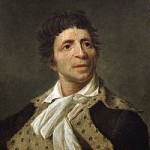 On this day in 1793, physician, political theorist, and scientist, Jean-Paul Marat was murdered in his bathtub in Paris by Charlotte Corday, a Girondist sympathizer. He was 50. His last words were to his wife Simonne, “Aidez-moi, ma chère amie!” (“Help me, my dear friend!”) Born on 24 May 1743 in Boudry, Principality of Neuenburg (Neuchâtel), Prussia (in present-day Canton of Neuchâtel, Switzerland). Perhaps best known for his career in France as a radical journalist and politician during the French Revolution. His journalism became renowned for its fierce tone, uncompromising stance toward the new leaders and institutions of the revolution, and advocacy of basic human rights for the poorest members of society. Marat was one of the most radical voices of the French Revolution. He became a vigorous defender of the sans-culottes, publishing his views in pamphlets, placards and newspapers, including the “L’ami du peuple”, which helped make him their unofficial link with the radical, republican Jacobin group that came to power after June 1793. In his death he became an icon to the Jacobins, a sort of revolutionary martyr, as portrayed in Jacque-Louis David’s famous painting of his death.
On this day in 1793, physician, political theorist, and scientist, Jean-Paul Marat was murdered in his bathtub in Paris by Charlotte Corday, a Girondist sympathizer. He was 50. His last words were to his wife Simonne, “Aidez-moi, ma chère amie!” (“Help me, my dear friend!”) Born on 24 May 1743 in Boudry, Principality of Neuenburg (Neuchâtel), Prussia (in present-day Canton of Neuchâtel, Switzerland). Perhaps best known for his career in France as a radical journalist and politician during the French Revolution. His journalism became renowned for its fierce tone, uncompromising stance toward the new leaders and institutions of the revolution, and advocacy of basic human rights for the poorest members of society. Marat was one of the most radical voices of the French Revolution. He became a vigorous defender of the sans-culottes, publishing his views in pamphlets, placards and newspapers, including the “L’ami du peuple”, which helped make him their unofficial link with the radical, republican Jacobin group that came to power after June 1793. In his death he became an icon to the Jacobins, a sort of revolutionary martyr, as portrayed in Jacque-Louis David’s famous painting of his death.
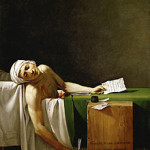 The Final Footprint – After his death, he was immortalized in various ways in order to preserve the values he stood for. His heart was removed and hung from the ceiling of the Cordeliers Club in order to inspire speeches that were similar in style to Marat’s eloquent journalistic skills. On his tomb, the inscription on a plaque read: “Unité, Indivisibilité de la République, Liberté, Égalité, Fraternité ou la mort”. His remains were transferred to the Panthéon on 25 November 1793 and his near messianic role in the Revolution was confirmed with the elegy: Like Jesus, Marat loved ardently the people, and only them. Like Jesus, Marat hated kings, nobles, priests, rogues and, like Jesus, he never stopped fighting against these plagues of the people. The eulogy was given by the Marquis de Sade, delegate of the Section Piques and an ally of Marat’s faction in the National Convention. On 19 November, the port city of Le Havre-de-Grâce changed its name to Le Havre-de-Marat and then Le Havre-Marat. When the Jacobins started their dechristianisation campaign to set up the Cult of Reason of Hébert and Chaumette and Cult of the Supreme Being of Robespierre, Marat was made a quasi-saint, and his bust often replaced crucifixes in the former churches of Paris. By early 1795, Marat’s memory had become tarnished. On 13 January 1795, Le Havre-Marat became simply Le Havre, the name it bears today. In February, his coffin was removed from the Panthéon and his busts and sculptures were destroyed. His final resting place is the cemetery of the church of Saint-Étienne-du-Mont.
The Final Footprint – After his death, he was immortalized in various ways in order to preserve the values he stood for. His heart was removed and hung from the ceiling of the Cordeliers Club in order to inspire speeches that were similar in style to Marat’s eloquent journalistic skills. On his tomb, the inscription on a plaque read: “Unité, Indivisibilité de la République, Liberté, Égalité, Fraternité ou la mort”. His remains were transferred to the Panthéon on 25 November 1793 and his near messianic role in the Revolution was confirmed with the elegy: Like Jesus, Marat loved ardently the people, and only them. Like Jesus, Marat hated kings, nobles, priests, rogues and, like Jesus, he never stopped fighting against these plagues of the people. The eulogy was given by the Marquis de Sade, delegate of the Section Piques and an ally of Marat’s faction in the National Convention. On 19 November, the port city of Le Havre-de-Grâce changed its name to Le Havre-de-Marat and then Le Havre-Marat. When the Jacobins started their dechristianisation campaign to set up the Cult of Reason of Hébert and Chaumette and Cult of the Supreme Being of Robespierre, Marat was made a quasi-saint, and his bust often replaced crucifixes in the former churches of Paris. By early 1795, Marat’s memory had become tarnished. On 13 January 1795, Le Havre-Marat became simply Le Havre, the name it bears today. In February, his coffin was removed from the Panthéon and his busts and sculptures were destroyed. His final resting place is the cemetery of the church of Saint-Étienne-du-Mont.
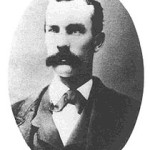 On this day in 1882, outlaw Cowboy of the American Old West who was affiliated with Ike Clanton and Frank Stilwell in Cochise County, Arizona Territory during 1881-1882, Johnny Ringo was found dead in the crotch of a large tree in West Turkey Creek Valley, near Chiricahua Peak, Arizona, with a bullet hole in his right temple and an exit wound at the back of his head. He was 32. A single shot had been heard by a neighbor late in the evening the day before on July 13. The property owner found Ringo sitting on the low-leaning trunk and fork of a large tree by the river (a fallen trunk next to which Ringo is now buried). Ringo’s revolver had one round expended and was found hanging by one finger in his hand. His feet were wrapped in pieces of his undershirt. His horse was found two weeks later, Ringo’s boots tied to the saddle of his horse, a common method to keep scorpions out of boots. After an inquest, the coroner found that death had been caused by a single shot through the head, and Ringo’s death was officially ruled a suicide. Born John Peters Ringo on 3 May 1850 in Greensfork, Indiana.
On this day in 1882, outlaw Cowboy of the American Old West who was affiliated with Ike Clanton and Frank Stilwell in Cochise County, Arizona Territory during 1881-1882, Johnny Ringo was found dead in the crotch of a large tree in West Turkey Creek Valley, near Chiricahua Peak, Arizona, with a bullet hole in his right temple and an exit wound at the back of his head. He was 32. A single shot had been heard by a neighbor late in the evening the day before on July 13. The property owner found Ringo sitting on the low-leaning trunk and fork of a large tree by the river (a fallen trunk next to which Ringo is now buried). Ringo’s revolver had one round expended and was found hanging by one finger in his hand. His feet were wrapped in pieces of his undershirt. His horse was found two weeks later, Ringo’s boots tied to the saddle of his horse, a common method to keep scorpions out of boots. After an inquest, the coroner found that death had been caused by a single shot through the head, and Ringo’s death was officially ruled a suicide. Born John Peters Ringo on 3 May 1850 in Greensfork, Indiana.
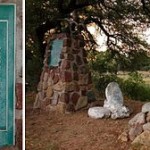 The Final Footprint – Ringo is buried close to where his body was found in West Turkey Creek Canyon at the base of the tree in which he was found, which fell around 2010. The grave is located on private land and is not publicly accessible. In the 1993 film Tombstone, Ringo is played by Michael Biehn. In this version, he is second in command of The Cowboys. He is characterized as a violent sociopath who aspires to humiliate and destroy Doc Holliday, portrayed by Val Kilmer. He is also characterized as highly educated, at one point trading taunts in Latin with Holliday. In the film, Holliday kills him.
The Final Footprint – Ringo is buried close to where his body was found in West Turkey Creek Canyon at the base of the tree in which he was found, which fell around 2010. The grave is located on private land and is not publicly accessible. In the 1993 film Tombstone, Ringo is played by Michael Biehn. In this version, he is second in command of The Cowboys. He is characterized as a violent sociopath who aspires to humiliate and destroy Doc Holliday, portrayed by Val Kilmer. He is also characterized as highly educated, at one point trading taunts in Latin with Holliday. In the film, Holliday kills him.
#RIP #OTD in 1946 photographer, modern art promoter, husband of Georgia O’Keeffe, Alfred Stieglitz died from a stroke in New York City with O’Keeffe by his side, aged 82. Cremated remains interred under a tree on the shore of Lake George, New York
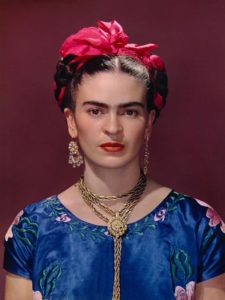 On this day in 1954, painter Frida Kahlo died at the age of 47 at her home, La Casa Azul in Coyoacán, Mexico City, Mexico. The official cause of death was pulmonary embolism, although no autopsy was performed. Born Magdalena Carmen Frida Kahlo y Calderón on July 6, 1907 in Coyoacán. Inspired by Mexican popular culture, she employed a naïve folk art style to explore questions of identity, postcolonialism, gender, class, and race in Mexican society. Her paintings often had autobiographical elements and mixed realism with fantasy. In addition to belonging to the post-revolutionary Mexicanidad movement, which sought to define a Mexican identity, Kahlo has been described as a Surrealist or magical realist. Her work has been celebrated internationally as emblematic of Mexican national and indigenous traditions, and by feminists for what is seen as its uncompromising depiction of the female experience and form.
On this day in 1954, painter Frida Kahlo died at the age of 47 at her home, La Casa Azul in Coyoacán, Mexico City, Mexico. The official cause of death was pulmonary embolism, although no autopsy was performed. Born Magdalena Carmen Frida Kahlo y Calderón on July 6, 1907 in Coyoacán. Inspired by Mexican popular culture, she employed a naïve folk art style to explore questions of identity, postcolonialism, gender, class, and race in Mexican society. Her paintings often had autobiographical elements and mixed realism with fantasy. In addition to belonging to the post-revolutionary Mexicanidad movement, which sought to define a Mexican identity, Kahlo has been described as a Surrealist or magical realist. Her work has been celebrated internationally as emblematic of Mexican national and indigenous traditions, and by feminists for what is seen as its uncompromising depiction of the female experience and form.Kahlo was interested in politics and in 1927 joined the Mexican Communist Party. Through the Party, she met the celebrated muralist Diego Rivera. They were married in 1928, and remained a couple until Kahlo’s death. The relationship was volatile due to both having extramarital affairs; they divorced in 1940, but remarried the following year.
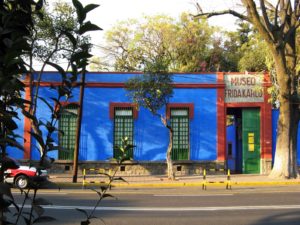 The Final Footprint –
The Final Footprint –
Kahlo seemed to anticipate her death, as she spoke about it to visitors and drew skeletons and angels in her diary. The last drawing was a black angel, which biographer Hayden Herrera interprets as the Angel of Death. Reportedly, it was accompanied by the last words she wrote, “I joyfully await the exit — and I hope never to return — Frida” (“Espero alegre la salida — y espero no volver jamás”).
Herrera has argued that Kahlo in fact died by suicide. The nurse, who counted Kahlo’s painkillers to monitor her drug use, stated that Kahlo had taken an overdose the night she died. She had been prescribed a maximum dose of seven pills, but had taken eleven. She had also given Rivera a wedding anniversary present that evening, over a month in advance.
On the evening of July 13, Kahlo’s body was taken to the Palacio de Bellas Artes, where it laid in state under a Communist flag. The following day, it was carried to the Panteón Civil de Dolores, where friends and family attended an informal funeral ceremony. In accordance with her wishes, Kahlo was cremated. Rivera, who stated that her death was “the most tragic day of my life”, died three years later in 1957. Kahlo’s ashes are displayed in a pre-Columbian urn at La Casa Azul, which was opened as a museum in 1958.
 On this day in 2010, the morning of the 2010 Major
On this day in 2010, the morning of the 2010 Major  League Baseball All-Star Game, United States Air Force veteran, shipping magnate, entrepreneur and owner of the New York Yankees, "The Boss", George Steinbrenner died of a heart attack at St. Joseph's Hospital in Tampa, Florida, at the age of 80. Born George Michael Steinbrenner III on 4 July 1930 in Rocky River, Ohio. During Steinbrenner's 37-year ownership, beginning in 1973, the longest in club history, the Yankees earned 7 World Series titles and 11 pennants. He received his B.A. from Williams College and his M.A. from Ohio State University. Steinbrenner was married once to Elizabeth Joan Zieg (1956-2010 his death).
League Baseball All-Star Game, United States Air Force veteran, shipping magnate, entrepreneur and owner of the New York Yankees, "The Boss", George Steinbrenner died of a heart attack at St. Joseph's Hospital in Tampa, Florida, at the age of 80. Born George Michael Steinbrenner III on 4 July 1930 in Rocky River, Ohio. During Steinbrenner's 37-year ownership, beginning in 1973, the longest in club history, the Yankees earned 7 World Series titles and 11 pennants. He received his B.A. from Williams College and his M.A. from Ohio State University. Steinbrenner was married once to Elizabeth Joan Zieg (1956-2010 his death).
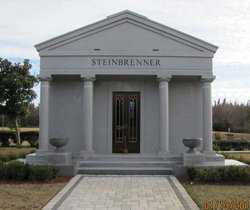 The Final Footprint - Steinbrenner is entombed in the Steinbrenner Private Mausoleum at Trinity Memorial Gardens in New Port Richey, Florida. The Steinbrenner family added a monument to Monument Park at Yankee Stadium on 20 September 2010 to honor Steinbrenner. Monument Park is an open-air museum containing a collection of monuments, plaques, and retired numbers honoring distinguished members of the Yankees. Other notable Yankees whose final footprints include memorialization in Monument Park; Mel Allen, Lou Gehrig, Joe DiMaggio, Billy Martin, Babe Ruth, Bob Sheppard, Thurman Munson, Mickey Mantle, Roger Maris, Phil Rizzuto, and Casey Stengel.
The Final Footprint - Steinbrenner is entombed in the Steinbrenner Private Mausoleum at Trinity Memorial Gardens in New Port Richey, Florida. The Steinbrenner family added a monument to Monument Park at Yankee Stadium on 20 September 2010 to honor Steinbrenner. Monument Park is an open-air museum containing a collection of monuments, plaques, and retired numbers honoring distinguished members of the Yankees. Other notable Yankees whose final footprints include memorialization in Monument Park; Mel Allen, Lou Gehrig, Joe DiMaggio, Billy Martin, Babe Ruth, Bob Sheppard, Thurman Munson, Mickey Mantle, Roger Maris, Phil Rizzuto, and Casey Stengel.
Have you planned yours yet?
Follow TFF on twitter @RIPTFF

